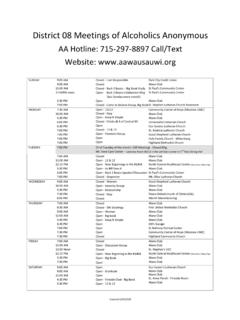Transcription of Quantifying Credit and Market Risk under Solvency II ...
1 Quantifying Credit and Market Risk under Solvency II: Standard approach versus internal model Nadine Gatzert, Michael Martin Working Paper Chair for Insurance Economics Friedrich-Alexander-University of Erlangen-N rnberg Version: October 2012. Quantifying Credit AND Market RISK under Solvency II: STANDARD approach versus internal model . Nadine Gatzert, Michael Martin . ABSTRACT. Even though insurers predominantly invest in bonds, Credit risk associated with government and corporate bonds has long not been a focus in their risk manage- ment. After the crisis of several European countries, however, Credit risk has re- cently been paid greater attention. Nevertheless, the latest version of the Solvency II standard model (QIS 5), provided by regulators for deriving Solvency capital re- quirements, still does not require capital for Credit risk inherent in, , EEA issued government bonds from Greece or Spain.
2 This paper aims to provide an alternative approach and compares the standard model with a partial internal risk model using a rating-based Credit risk model that accounts for Credit , equity, and interest rate risk inherent in a portfolio of stocks and bonds. The findings demonstrate that sol- vency capital requirements strongly depend on the quality and composition of an insurer's asset portfolio and that model risk in regard to model choice and calibra- tion plays an important role in the quantification. Keywords: Solvency II; internal model ; rating-based Credit risk model ; Market risk; Credit risk JEL Classification: G22, G32, G38.. Nadine Gatzert and Michael Martin are at the Friedrich-Alexander-University (FAU) of Erlangen-N rnberg, Chair for Insurance Economics, Lange Gasse 20, 90403 N rnberg, Germany.
3 Email: nad- 1. 1. INTRODUCTION. Credit risk has long not been in the focus of many insurance companies, even though a major part of their capital investments are held in government and corporate bonds generally ex- posed to Credit risk. However, the recent crises in Greece, Ireland, Spain or Portugal have demonstrated the strong need for adequate Credit risk models for insurers, since it cannot gen- erally be taken for granted that highly indebted countries obtain the needed financial support. For this reason, Credit risk modeling has received increased attention in insurers' risk man- agement. In this paper, we compare the latest proposed standard model of 2010/2011 to be used in the European supervisory system Solvency II (planned to be in force from 2013 on) to quantify Market and Credit risk for a non-life insurance company with a partial internal model that assesses the Market risk situation of an insurer.
4 Special focus is paid to the effect of Credit risk while further examining the impact of dependencies between the relevant processes with respect to diversification benefits. Furthermore, we analyze model risk for the internal ap- proach regarding the model choice as well as the model calibration. Since the Basel II reform of European banking supervision in 2006, insurance supervision has also fundamentally been reformed. In particular, the European Union (EU) Solvency II regu- lation will impose risk-based capital requirements for insurance companies and is planned to be implemented after 2013, thereby explicitly accounting for Market and Credit risks. To cal- culate the Solvency capital requirements (SCR), insurers have the option to choose between five different methods.
5 Besides the standard formula provided by the regulator, the SCR can be calculated by using the standard model with a partial internal model , with undertaking- specific parameters, with simplifications, or by modeling the insurers' risks with a full inter- nal model approved by the supervisors (see European Parliament and of the Council, 2009, Article 112, No. 1 to 7).1 However, the latest proposed standard model of 2010/2011 does not require capital concerning Credit spread risk for investments in government bonds issued by countries of the European Economic Area (EEA) or borrowings guaranteed by one of these states, including, , Greece or Ireland. While Credit risk has been extensively researched in the context of the valuation of defaultable bonds2, applications to insurance companies have hardly been addressed so far.
6 With respect 1. See Gatzert and Wesker (2012) for a detailed overview of the different methods to derive the SCR according to Solvency II along with a comparison to Basel II/III, and Eling, Schmeiser, and Schmit (2007) for an over- view of the Solvency II framework in general. 2. See Black and Scholes, 1973, Merton, 1973, 1974, Black and Cox, 1976, Leland 1994, and Longstaff and Schwarz, 1995, for structural models, and Jarrow and Turnbull, 1995, Das and Tufano, 1996, Jarrow, Lando, 2. to Solvency II, a study by Fitch Ratings (Piozot et al., 2011) discusses the implications of the new regulatory regime in regard to the insurers' asset allocation and the attractiveness of dif- ferent asset classes. One main finding is that insurers will likely have to increase their invest- ments in higher-rated corporate and government bonds.
7 At the same time, Solvency II implies investments in shorter-term bonds instead of long-term debt due to ceteris paribus higher cap- ital requirements for long durations (while the asset-liability mismatch is simultaneously re- duced) as well as a low level of equity holdings. In addition, as a consequence of the special treatment in terms of the capital requirements for government bonds from members of the EEA under Solvency II, the authors also assume that these bond exposures will gain more importance for the insurers' asset allocation. However, in this context, it should also be taken into account that even if the standard model is used instead of an internal model , according to Solvency II's Pillar 2, the insurer's own risk and Solvency assessment (ORSA) requires an adequate assessment of the company's risk situa- tion, which also includes the consideration of Credit risk.
8 Thus, even if the standard model currently does not require adequate capital for Credit risk of EEA states, this risk will certainly have to be taken into account within the ORSA process. A different aspect is analyzed in a study by Mittnik (2011), which focuses on the applied cali- bration procedure for the standard model and particularly points out flaws regarding the use of the rolling-window annualization procedure. For instance, wrongly implied correlations be- tween asset classes, even if returns are independent, do not adequately reflect diversification benefits. Christiansen, Denuit, and Lazar (2012) examine the calibration of the aggregation formula ( square-root formula ) used to derive the life underwriting risk in the Solvency II.
9 Standard model . Applying a stochastic model for an internal approach , they identify the corre- lation matrix in the life module of the Solvency II standard model as not appropriate, leading to an overestimation for the underlying German data set. Further critical discussions about the aggregation formula in the Solvency II standard model can be found in Sandstr m (2007) and Pfeifer and Strassburger (2008). Sandstr m (2007) shows how the standard formula needs to be recalibrated if the probability distributions of the underlying risk factors are skewed (in- stead of being symmetric and normally distributed, even if risks are independent) in order to ensure consistency. Pfeifer and Strassburger (2008) point out how the overall SCR is misspe- cified even if the aggregate probability distribution of the risks is symmetric and if the under - lying risks are uncorrelated but dependent.
10 And Turnbull, 1997, Duffie and Singleton, 1997, Lando, 1998, and Duffie and Singleton, 1999, regarding re- duced-form models. 3. Thus, the question arises to what extent an internal model leads to different capital require- ments as compared to the Solvency II standard model in the current calibration if Market risks including equity, interest rate and Credit spread risk are adequately quantified. Therefore, the aim of this paper is to compare an alternative internal approach with the standard model in the case of a non-life insurance company, thereby focusing on the asset side and the induced mar- ket risk. We specifically investigate the importance of an adequate quantification of Credit spread risk with regard to the capital investment of insurers, and thus focus on the insurer's asset side, looking at stocks and bonds as the relevant asset classes.



